Abstract
Two new species of Benthana Budde-Lund, 1908 are described from material collected in the states of Rio de Janeiro and Paraná, Brazil. Benthana schmalfussi n. sp. is distinguished by the shape of the male pleopod 1 exopod, whereas Benthana guayanas n. sp. is distinguished by the noduli laterales d/c coordinates and shape of the male pleopod 1 exopod. A new method is given for defining the shape of the outer distal margin of the male pleopod 1 exopod.
http://zoobank.org/urn:lsid:zoobank.org:pub:A79EDB3B-F7AC-47A3-ADD8-DA00FFAD69CB
Introduction
The family Philosciidae Kinahan, Citation1857, considered paraphyletic (Schmidt Citation2008), includes almost 600 species in 114 genera with a wide distribution (Leistikow Citation2001; Schmalfuss Citation2003). The genus Benthana Budde-Lund, Citation1908 includes 21 species (two dubious species from Chile excluded) (Schmalfuss Citation2003; Leistikow and Araujo Citation2006; Sokolowicz et al. Citation2008; Campos-Filho and Araujo Citation2011). All species are recorded from Brazil, and only one, Benthana picta (Brandt, Citation1833), is also found in Paraguay (Andersson Citation1960; Araujo et al. Citation1996; Schmalfuss Citation2003). In Brazil, members of Benthana occur from the state of Minas Gerais (19°32′S, 44°27′W) to the state of Rio Grande do Sul (29°52′S, 50°47′W). Several species, e.g. B. picta, are widely distributed and 12 species are known to occur only in the type-locality (including one from a cave).
The most important character in defining the genus Benthana is the presence of the dentiform protrusion on the male pleopod 1 exopod (see Leistikow Citation2001: 34). However, there is a wide variation in the shape of the exopod among the different species, but it is difficult to be defined in order to compare the species. In a first attempt to quantify the variation and erect a discrete character, which is important in a cladistic context (sensu Goloboff et al. Citation2006), Araujo and Lopes (Citation2003: 2427) defined the shape of this appendage as elongated or rounded, based on the z:y ratio, measurement calculated by the distance between the maximum re-entrance point from the outer margin to the internal margin (y) in respect of central axis of the exopod (e), and the maximum height measured from the apex in relation to the axis (z).
Recently, we began a taxonomic revision of the genus with the examination of material deposited in Brazilian collections and material collected in recent expeditions in southern Brazil. Among this material we identified two new species, one from the state of Rio de Janeiro and one from the state of Paraná, described herein. A new method is also given for defining the shape of the outer distal margin of the male pleopod 1 exopod and analyzing the apical outline of the appendage, which presents an indentation quantified as “low”, “medium”, or “high” (Figure ). The quantitative representation of this character is based on the change of an angle, which is formed from measurements of homologous points on the appendage (Figure ). Each species of Benthana fits one of three categories as shown in Table .
Figure 1 Male pleopod 1 exopod, categories of the shape of the outer distal margin. A: Benthana picta (Brandt, Citation1833); B: Benthana longicaudata (Lemos de Castro, Citation1958); C: Benthana schmalfussi n. sp.

Figure 2 Male pleopod 1 exopod: indentation depth of the outer distal margin. e, central axis (sensu Araujo and Lopes Citation2003); E, distal point of central axis; A, distal point of the dentiform protrusion; B, point of maximum depth of the indentation measured from line (a); a, line between A and E; b, line between B and E; α, angle defining the depth of the indentation.
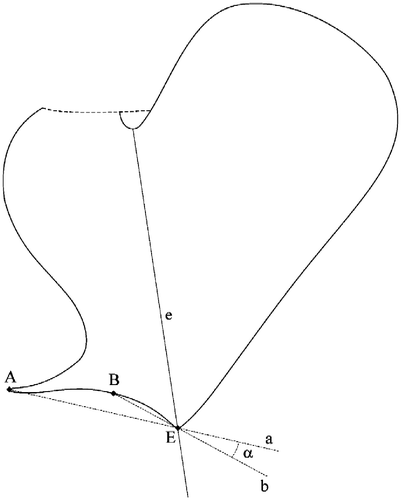
Table 1 Benthana species grouped according to the three categories of the angle measured on the outer distal margin of the male pleopod 1 exopod (see Figures and ).
Material and methods
Specimens were stored in 70% ethanol and descriptions were based on morphological characters. The specimens were dissected and the appendages and pereonites were mounted on slides. Drawings were prepared using a camera lucida. The noduli laterales were measured and illustrated as in Vandel (Citation1962). The z:y ratio of the male pleopod 1 exopod was defined according to Araujo and Lopes (Citation2003).
In order to define the shape of the outer distal margin of the male pleopod 1 exopod, we used the distal point (E) of the central axis (e) proposed by Araujo and Lopes (Citation2003), in which two lines cross, one from the apex of the dentiform protrusion (A) and the other from the maximum depth of the indentation of the outer distal margin (B) measured from line (a) (Figure ); the intersection of lines (a) and (b) in (E) forms an angle (α), the measure of which defines the depth of the indentation. We propose three categories: low indentation (0° ≥ 5°), medium indentation (6° ≥ 20°), and high indentation ( ≥ 21°). These intervals were chosen because all the species of Benthana that we have examined group around the middle value of each category.
The material has been deposited at the Museu Nacional (MNRJ), Universidade Federal do Rio de Janeiro, Rio de Janeiro; Museu de Zoologia (MZUSP), Universidade de São Paulo, São Paulo; and Coleção de Carcinologia (UFRGS), Universidade Federal do Rio Grande do Sul, Rio Grande do Sul.
Systematic account
Family Philosciidae Kinahan, Citation1857
Genus Benthana Budde-Lund, Citation1908
Diagnosis
See Araujo and Leistikow (Citation1999), Leistikow (Citation2001), and Campos-Filho and Araujo (Citation2011).
Benthana schmalfussi n. sp.
(Figures )
Figure 3 Benthana schmalfussi n. sp. (male paratype). A: habitus; B: cephalon, dorsal view; C: cephalon, frontal view; D: pereon epimeron 4; E: noduli laterales coordinates d/c; F: noduli laterales coordinates b/c; G: telson; H: antennule; I: left mandible; J: right mandible; K: maxillule; L: maxilla; M: maxilliped. Scales: A = 1 mm; B and C = 0.16 mm; D, G–M = 0.1 mm.
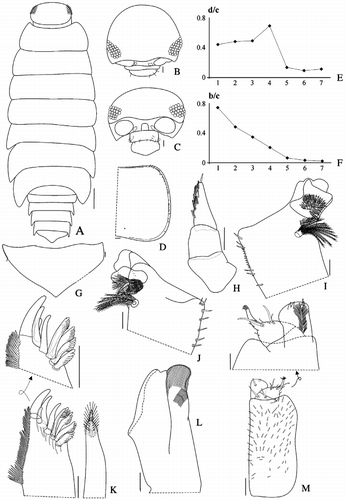
Figure 4 Benthana schmalfussi n. sp. (male paratype). A: pereopod 1; B: pereopod 2; C: pereopod 3; D: dactylus; E: pereopod 4; F: pereopod 5; G: pereopod 7. Scales: 0.1 mm.
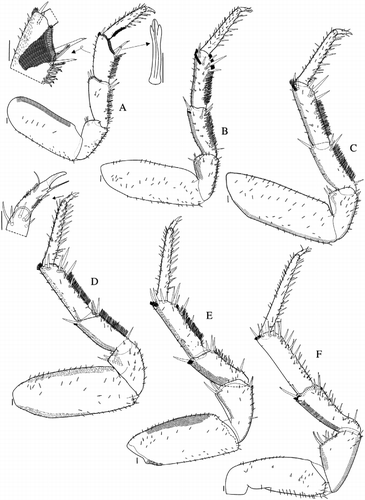
Figure 5 Benthana schmalfussi n. sp. (male paratype). A: pleopod 1 exopod; B: pleopod 1 endopod; C: pleopod 2 exopod; D: pleopod 2 endopod; E: pleopod 3; F: pleopod 4 exopod; G: pleopod 5 exopod; H: genital papilla; I: uropod. Scales: 0.1 mm.

Type material
Holotype ♂, Brazil, Rio de Janeiro, Maricá, Caxito Grande, 16/X/1988, leg. A. B. Kury, under woods and stones, small secondary forest, near to monoculture, I.PH. 78 (MNRJ 8345). Paratypes: 1 ♂ (in slides), 6 ♀♀, same data as holotype (MNRJ 23406).
Diagnosis
Antennule with 20 aesthetascs, proximal tooth of inner set of outer endite of maxillule with seven denticles, merus and carpus of male pereopods 1–5 setose, shape of male pleopod 1 exopod, male pleopod 5 exopod with eight setae, and uropod branches inserted at different levels.
Description of male
Maximum body length 12 mm, cephalothorax width 2.1 mm.
Specimens pale because of long preservation in ethanol 70%.
Body (Figure ) convex; dorsal surface smooth and bright, bearing few long piliform setae; pleon narrower than pereon with developed epimera; pereonites 1–4 with postero-lateral corners right-angled with rounded apices and posterior margins straight; pereonites 5–7 with postero-lateral corners gradually more acute and posterior margins gradually more arched; pleon epimera 3–5 developed, triangular, acute, and directed backwards. Cephalon (Figure ,C) with linea supra-antennalis sinuous; linea frontalis and lateral lobes lacking; clypeus and labrum similar in length; eyes with 20 ommatidia arranged in four rows. Pereonites (Figure ) with sulcus marginalis and glandular pores along the lateral margin. One line of noduli laterales per side (Figure ,F) with d/c coordinates reaching a maximum on pereonite 4; b/c coordinates gradually decreasing. Telson (Figure ) triangular with lateral margins straight.
Antennule (Figure ) triarticulate, distal article the longest, with 20 aesthetascs plus apical pair. Antenna not examined, missing in all specimens.
Mandibles (Figure ,J) with at least 15 branches on pars molaris, pars intermedia with dense tuft of coniform setae, left mandible with four penicils, and right mandible with two penicils. Maxillule (Figure ) medial endite with two penicils, inserted transversely, distal portion rounded; outer endite with 4+6 teeth, five teeth of inner set pectinate, one short and simple; proximal tooth with seven denticles. Maxilla (Figure ) lateral lobe twice as wide as median lobe with distal margin sinuous, covered with trichiform setae; median lobe rounded, covered with trichiform setae. Maxilliped (Figure ) with rectangular base, cuticle scaled proximally, sparse piliform setae, and outer distal corner slightly prominent; endite rectangular, outer margin sinuous, distal margin broadly rounded, medial seta surpassing the distal margin, two hooks on distal margin, and longitudinal ridge bearing dense setae ending with a triangular tooth.
Pereopods (Figure –F) rather slender, bearing sparse piliform setae on all articles, and hyaline fringe of scales; merus and carpus of pereopods 1–5 setose; carpus 1 with transverse antenna-grooming brush and two setae with hand-like apex; ischium 7 triangular, bearing eight long setae; dactylus 1–7 with inner claw reaching distal margin of outer claw, dactylar seta long and simple, ungual seta simple, not surpassing inner claw.
Pleopod 1 (Figure ,B) exopod heart-shaped, elongated (ratio z:y = 2.07), dentiform protrusion prominent with acute apex, outer lateral margin of respiratory area with 11 setae, outer distal margin with high indentation ( ≥ 20°); endopod stout with median row of short setae on distal portion. Pleopod 2 (Figure ,D) exopod triangular, outer margin convex with about 20 setae; endopod slender and long, reaching pleopod 4. Pleopods 3 and 4 exopods as in Figure ,F. Pleopod 5 exopod (Figure ) triangular, outer margin slightly sinuous with eight setae and transverse plumose fringe.
Genital papilla (Figure ) with triangular frontal shield distally rounded and two subapical orifices.
Uropod (Figure ) with protopod grooved on outer margin, endopod and exopod inserted at different levels, with few long setae along inner and outer margins; exopod twice as long as endopod, with five setae on apex; endopod with three setae on apex.
Description of female
Maximum body length 16.8 mm, cephalothorax width 2.2 mm. Similar to male, except in sexual characters, fewer setae on pereopods, and ischium 7 longer than in male.
Etymology
The new species is named after Dr Helmut Schmalfuss for his invaluable contribution to the knowledge of Oniscidea.
Remarks
Benthana schmalfussi n. sp. is distinguished from all other species in the genus by the shape of the male pleopod 1 exopod. Although the “high indentation” (see Table ) is comparable with that of other species, B. schmalfussi differs in the larger number of aesthetascs on the antennule (20+2 vs. 13+2 in B. longicornis; 15+2 in B. cairensis and B. serrana; 9+2 in B. sulcata) and the setose male pereopods 1–5.
Benthana guayanas n. sp.
(Figures )
Figure 6 Benthana guayanas n. sp. (male paratype). A: habitus; B: cephalon dorsal view; C: cephalon frontal view; D: noduli laterales coordinates d/c; E: noduli laterales coordinates b/c; F: telson; G: epimera 4; H: antennule; I: antenna; J: left mandible; K: right mandible; L: maxillule; M: maxilla; N: maxilliped. Scales: A = 1 mm, B and C = 0.16 mm, F–N = 0.1 mm.
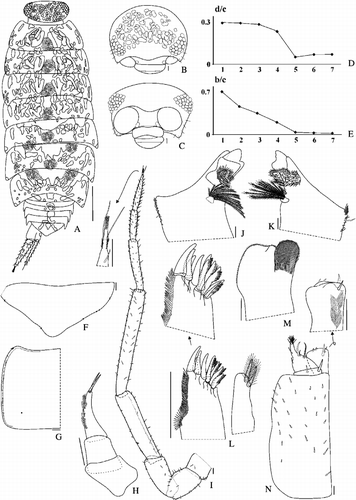
Figure 7 Benthana guayanas n. sp. (male paratype). A: pereopod 1; B: pereopod 2; C: pereopod 7. Scales: 0.1 mm.
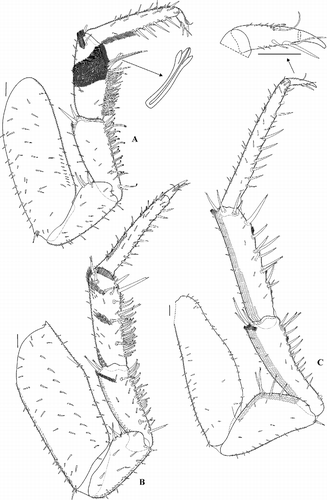
Figure 8 Benthana guayanas n. sp. (male paratype). A: pleopod 1 exopod; B: pleopod 1 endopod; C: pleopod 2 exopod; D: pleopod 2 endopod; E: pleopod 3; F: pleopod 4; G: pleopod 5; H: genital papilla; I: uropod. Scales: 0.1 mm.
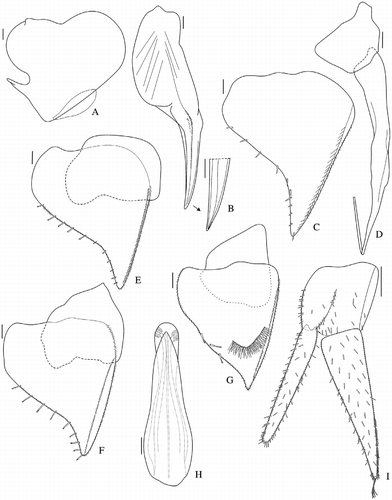
Type material
Holotype ♂, Brazil, Paraná, Morretes, 09/IV/1999, leg. Pinto-da-Rocha and A. Chagas MZUSP 24314). Paratypes: 2 ♂♂, 6 ♀♀, same data as holotype (MZUSP 28129); Brazil, Paraná: 1 ♂, 1 ♀, Estrada da Graciosa, São João da Graciosa, 25°20′03″S, 48°53′54″W, 740 m, 10.VIII.2012, leg. B.L. Zimmermann and P.B. Araujo (MZUSP 28130); 1 ♂ (part in slides), Road PR 508, Matinhos, near to the National Park of Saint-Hilaire/Lang, 25°38′39″S, 48°36′05″W, 10.VIII.2012, leg. B.L. Zimmermann and P.B. Araujo (UFRGS 5434P); 1 ♂ (part in slides), 1 ♀, Estrada da Graciosa, São João da Graciosa, 740 m, 10.VIII.2012, leg. B.L. Zimmermann and P.B. Araujo (UFRGS 5435P).
Diagnosis
Noduli laterales d/c coordinates, antennule with 9–11 aesthetascs, proximal tooth of inner set of outer endite of maxillule with 15 denticles, merus and carpus of male pereopods 1 and 2 setose, small lobe on inner lateral margin of male pleopod 1 exopod and outer distal margin with low indentation ( ≤ 5°).
Description of male
Maximum body length 10.2 mm, cephalothorax width 1.7 mm.
Color (Figure ) brown with antennae completely pigmented; cephalon with irregular unpigmented spots; pereon centrally with longitudinal unpigmented spots, more marked on pereonites 5–7; pereonites 1–7 with postero-central rounded pigmented area, 6 and 7 with two paramedian pigmented areas; pleon pigmented and telson pigmented centrally with pale areas.
Body (Figure ) convex; dorsal surface smooth and bright, bearing long piliform setae; pleon narrower than pereon with developed epimera; pereonites 1–3 with postero-lateral corners right-angled with rounded apices, and posterior margins straight; pereonites 4–7 with postero-lateral corners gradually more acute and posterior margins gradually more arched; pleon epimera 3–5 developed, triangular, acute, and directed backwards. Cephalon (Figure ,C) with linea supra-antennalis sinuous; linea frontalis and lateral lobes lacking; clypeus and labrum similar in length; eyes with 22 ommatidia arranged in four rows. One line of noduli laterales per side (Figure ,E) with d/c coordinates reaching a maximum on pereonites 1 and 2; b/c coordinates gradually decreasing. Telson (Figure ) triangular with lateral margins slightly convex. Pereonites (Figure ) with sulcus marginalis and glandular pores along the lateral margin.
Antennule (Figure ) triarticulate, distal article the longest, with 9–11 aesthetascs plus apical pair. Antenna (Figure ) when extended posteriorly reaches fourth pereonite; flagellum triarticulate, third article longest; apical organ short, one-quarter of the length of the distal article, free sensilla inserted near the base.
Mandibles (Figure ,K) with at least 15 branches on pars molaris, pars intermedia with dense tuft of coniform setae, left and right mandibles with three penicils. Maxillule (Figure ) medial endite with two penicils, inserted transversely, distal portion rounded; outer endite with 4+6 teeth, five teeth of inner set pectinate, one short and simple; proximal tooth with 15 denticles. Maxilla (Figure ) lateral lobe twice as wide as median lobe, distal margin sinuous, covered with trichiform setae; median lobe rounded, covered with trichiform setae. Maxilliped (Figure ) with rectangular base, cuticle scaled proximally, sparse piliform setae, and distal margin straight; endite rectangular, outer margin slightly sinuous, distal margin broadly rounded, medial seta surpassing the distal margin, two hooks on distal margin, and longitudinal ridge bearing dense setae and ending with one tooth.
Pereopods (Figures 7A–C) rather slender, piliform setae on all articles and hyaline fringe; merus and carpus of pereopods 1 and 2 setose; carpus 1 with transverse antenna-grooming brush and one setae with hand-like apex; ischium 7 triangular, bearing five long setae; dactylus 1–7 with inner claw reaching distal margin of outer claw, dactylar seta long and simple, ungual seta simple, not surpassing inner claw.
Pleopod 1 (Figure ,B) exopod heart-shaped, rounded (ratio z:y = 1.88), small lobe on inner margin, dentiform protrusion prominent with acute apex and obliquely directed backwards, outer distal margin with low indentation ( ≤ 5°); endopod stout and sinuous, bearing distal row of setae and apex acute. Pleopod 2 (Figure ,D) exopod triangular, outer margin convex, with about 11 setae; endopod slender and long, reaching pleopod 4. Pleopods 3 and 4 as in Figure ,F. Pleopod 5 exopod (Figure ) triangular, outer margin slightly sinuous, with three setae and transverse plumose fringe.
Genital papilla (Figure ) with triangular frontal shield distally rounded and two subapical orifices.
Uropod (Figure ) with endopod and exopod inserted at the same level, with few long setae along inner and outer margins; exopod longer than endopod with five setae on apex; endopod with four sensory setae on apex.
Description of female
Maximum body length 12.7 mm, cephalothorax width 2.3 mm. Similar to male, except in sexual characters. Antennae when extended posteriorly reach fifth pereonite; third flagellum article five times longer than apical organ; proximal tooth of outer endite of maxillule with 12 denticles; fewer setae on pereopods.
Etymology
The new species is named after the Guayanas people native to southeastern and southern Brazil.
Remarks
Benthana guayanas n. sp. resembles B. itaipuensis, B. olfersii, and B. taeniata in the male pleopod 1 exopod with a lobe on inner margin and a low indentation. Benthana guayanas n. sp. is distinguished by the noduli laterales d/c coordinates, proximal tooth of outer endite of maxillule with 15 denticles in the male, and shape of lobe on male pleopod 1 exopod.
Acknowledgements
We are grateful to Dr Cristiana Serejo from MNRJ, and Dr Marcos Tavares and Mauro Cardoso from MZUSP for the loan of material and assistance in material deposit; to Viviane Torres for the illustrations; to Conselho Nacional de Desenvolvimento Científico e Tecnológico and Coordenação de Aperfeiçoamento de Pessoal de Nível Superior for the financial support and scholarships given to PBA, ISCF and SLNC (MCT/CNPq/MEC/CAPES/PROTAX 562202/2010-2; CAPES/PDSE 9156/11-9), and for a productivity fellowship to PBA.
References
- Andersson , Å . 1960 . South American terrestrial isopods in the collection of the Swedish State Museum of Natural History . Arkiv för Zoologi , 12 : 537 – 570 .
- Araujo , PB , Bond-Buckup , G and Buckup , L . 1996 . Isópodos terrestres (Crustacea, Oniscidea) de Santa Catarina e Rio Grande do Sul, Brasil . Iheringia , 81 : 111 – 134 .
- Araujo , PB and Buckup , L . 1994 . Two new species of terrestrial Isopoda from southern Brasil (Crustacea, Isopoda, Oniscidea) . Spixiana , 17 : 269 – 274 .
- Araujo , PB and Leistikow , A . 1999 . Philosciids with pleopodal lungs from Brazil, with description of a new species (Crustacea, Isopoda) . Contributions to Zoology , 68 ( 2 ) : 109 – 141 .
- Araujo , PB and Lopes , ERC . 2003 . Three new species of Benthana Budde-Lund (Isopoda, ‘Philosciidae’) from Brazil . Journal of Natural History , 37 ( 20 ) : 2425 – 2439 .
- Budde-Lund , G . 1908 . Isopoda von Madagaskar und Ostafrika mit Diagnosen verwandter Arten . In: Voeltzkow A, editor. Reise in Ostafrikain den Jahren 1903–1905. Wissenschaftliche Ergebnisse 2: 265-308, pls 12–18
-
Brandt
,
I
.
1833
.
Conspectus Monographiae Crustaceorum Oniscodorum Latreillii
.
Byulleten Moskovskogo Obshchestva Ispŷtatele
Prirodŷ , 6 : 171 – 193 . pl. 4
- Campos-Filho , IS and Araujo , PB . 2011 . New species of Benthana Budde-Lund, 1908 (Crustacea: Oniscidea: Philosciidae) from Paraná . Brazil. Zootaxa , 2765 : 38 – 46 .
- Goloboff , PA , Mattoni , CI and Quinteros , AS . 2006 . Continuous characters analyzed as such . Cladistics , 22 : 589 – 601 .
- Gruner , H . 1955 . Die Gattung Benthana Budde-Lund, 1908 (Isopoda, Oniscoidea) . Zoologische Jahrbücher, Abteilung für Systematik, Ökologie und Geographie der Tiere , 83 : 441 – 452 .
- Kinahan , J . 1857 . Analysis of certain allied genera of terrestrial isopods; with description of a new genus, and a detailed list of the British species of Ligia, Philougria, Philoscia, Porcellio, Oniscus and Armadillium . Natural History Review , 4 : 258 – 282 . pls 19–22
- Leistikow , A . 2001 . Phylogeny and biogeography of South American Crinocheta, traditionally placed in the family “Philosciidae” (Crustacea: Isopoda: Oniscidea) . Organisms, Diversity and Evolution , 4 : 1 – 85 .
- Leistikow , A and Araujo , PB . 2006 . The systematic position of Benthanoscia longicaudata Lemos de Castro, 1958 (Isopoda: Oniscidea: Crinocheta) . Systematics and Biodiversity , 4 ( 3 ) : 243 – 254 .
- Lemos de Castro , A . 1958 . Revisão do gênero Benthana Budde-Lund, 1908 (Isopoda, Oniscidae) . Arquivos do Museu Nacional , 44 : 85 – 118 .
- Lemos de Castro , A . 1985 . Duas espécies novas brasileiras de Benthana Budde-Lund, 1908 (Isopoda, Oniscoidea, Philosciidae) . Revista Brasileira de Biologia , 45 : 241 – 247 .
- Lima , IMB and Serejo , CS . 1993 . New species of Benthana Budde-Lund from Brazilian caves (Crustacea; Isopoda; Oniscoidea) . Proceedings of the Biological Society of Washington , 106 : 490 – 496 .
- Schmalfuss , H . 2003 . World catalog of terrestrial isopods (Isopoda: Oniscidea) . Stuttgarter Beiträge zur Naturkunde , 654 : 1 – 341 . [cited 2010 Aug 25] Available from: http://www.oniscidea-catalog.naturkundemuseum-bw.de/Cat_terr_isop.pdf
- Schmidt , C . 2008 . Phylogeny of terrestrial Isopoda (Oniscidea): a review . Arthropod Systematics and Phylogeny , 66 ( 2 ) : 191 – 226 .
- Sokolowicz , CC , Araujo , PB and Boelter , JF . 2008 . A new species of Benthana (Crustacea: Isopoda: Philosciidae) from southern Brazil . Revista Brasileira de Zoologia , 25 ( 2 ) : 314 – 318 .
- Vandel A. 1962. Isopodes Terrestres (Deuxieme partie). In: Faune de France. Paris, P. Lechevalier 66: 417–931
- Verhoeff , K . 1941 . Zur Kenntnis südamerikanischer Oniscoideen . Zoologischer Anzeiger , 133 : 114 – 126 .